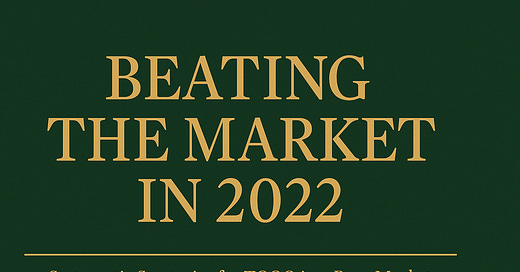🛡️ How We Beat the Market in 2022 — by a Mile
While the Nasdaq dropped –33%, our system stayed alive — and set up the rebound.
2022 was brutal.
The Nasdaq lost –33%. TQQQ, the 3x leveraged version, fell nearly 80%. Most investors were caught off guard. But our system wasn’t built to predict the future — it was built to survive scenarios like this.
Let’s break it down.
The NASDAQ Playbook is based on a multi-model architecture. Instead of relying on a single strategy, we combine three uncorrelated systems — each designed for a different market regime. That structure is what protected us.
Let’s be clear: our Core System got hit. And that’s exactly what you’d expect in a year with no sustained trend — just rolling over, chopping sideways, and breaking lower. In isolation, the Core posted –48%, which sounds ugly — but in a year when TQQQ fell –78%, that’s already a big improvement.
But here’s the key:
That weakness was offset — and then some — by the other two systems.
🎯 Net result: –24.00% + 7.75% + 13.25% = –3.00% in 2022
This Wasn’t a Victory Lap — It Was a Stress Test
When we built this model, we didn’t optimize for perfect years. We optimized for durability. We wanted something that could take a hit and still be standing — ready for the next bull run. That’s why resilience is a feature, not a side effect.
In 2022, the market gave us the ultimate test:
Violent selloffs
False rallies
High volatility
Broken trend structure
That’s the worst possible environment for classic trend-following. And yes — the Core Momentum Model took damage, giving back part of its gains from the 2020–2021 bull. That’s how the system is designed. It follows, it doesn’t predict. And when trends unwind slowly, it exits late. That’s not a bug. It’s the cost of catching big moves like in 2023 or 2024.
But while Core was getting whipsawed, the RSI + MACD Filter stepped in. Built to detect oversold conditions and early reversals, it caught the sharp rebounds — particularly in March, June, and October. It avoided staying long in failed rallies. It’s fast. It’s reactive. And it delivered -3% in a year where the Nasdaq was down –33%.
Even more powerful was the Heikin-Ashi Crash Model. This system isn’t polite. It doesn’t wait. When volatility spikes and momentum breaks down, it exits fast. Then it reenters quickly after forced liquidation and panic selling. In 2022, it activated early, moved nimbly, and managed to lock in a stunning +53% return — its best year on record.
And when you combine all three?
Weighted together, the portfolio didn’t just hold the line — it actually grew.
Despite a 50% allocation to a system that lost almost half its capital, the overall result was a gain of -3%, driven by the complementary strength of the other two models.
While the Nasdaq-100 lost –33%, our system returned -3%.
That’s a 30-percentage-point spread — in a down year.
Let that sink in.
Surviving the Storm Is What Let Us Ride the Rebound
Most strategies don’t fail in bear markets because they’re bad. They fail because they don’t have an answer for volatility. Or because they rely on trend-following alone. Or worse — on discretionary judgment. That’s not how we operate.
We don’t guess. We don’t hope. We follow structure.
2023: 111% return
2024: 60% return
That’s the point of this model.
Not to win every year.
But to lose small when others lose big, and then lean in when the time is right.
What This Means for You
2022 was not an exception. It was a preview.
A high-volatility regime, rising rates, macro instability — these will come again.
The question is not whether you can predict them.
The question is: Do you have a structure that survives them?
The NASDAQ Playbook does. And not just on paper — but live, in real markets.
The -3% return in 2022 wasn’t luck. It was architecture. It was tested logic. And it was exactly what we designed this system to do.
🔒 Subscribe for Weekly Signals & System Updates
📬 Read the Latest Model Breakdown
No guessing. No ego. Just tested structure.
— Felix
Founder, The Nasdaq Playbook
📌 Disclaimer: This newsletter is for educational purposes only and does not constitute financial advice. All investments carry risk. Past performance is no guarantee of future results. Always conduct your own due diligence.






When was the last trade taken by the model?
Beating the market in 2022 doesnt matter what were the results in 2023 and 2024. Do we have any trade logs?